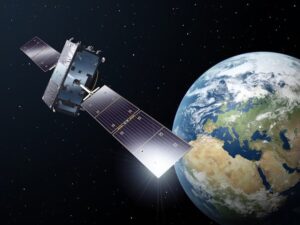The constellation’s navigational services were uninterrupted as it drew on 22 operational satellites in the network, according to Pierlugi Fedele, Galileo service provision manager at prime contractor Spaceopal.
Spaceopal, a joint venture between European space mission integrator Telespazio and German space agency DLR, received an alert Feb. 21 from the EU Space Surveillance and Tracking (EUSST) consortium of a potential collision in 10 days.
Fedele and his team at Spaceopal spent the time leading up to its emergency maneuver assessing the risk and how to counter it without interrupting Galileo’s services.
It took two station-keeping maneuvers over 10 days between March 9 and March 19 to put GSAT0219 back into place. The Ariane 4 debris has been floating around in space since its launch in 1989.
A growing concern
The European Space Agency’s Aeolus satellite had to make similar maneuvers in low Earth orbit (LEO) in September 2019, when it determined that a Starlink broadband satellite from SpaceX would pass too close.
Earlier this year, an alleged close approach with a Starlink satellite prompted OneWeb to move one of its recently launched broadband spacecraft.
The majority of navigational satellites are in MEO at around 22,000 kilometers, far above the LEO broadband operators placing spacecraft up to about 1,000 kilometers.
“Although MEO currently presents less problems in terms of possible collisions, above all if compared with geostationary (GEO) and LEO orbits, as the number of space launches grows we expect an exponential increase in debris created by the launcher stages, which are left floating in space at that precise level of orbit,” Fedele said.
“The number of potential collisions between debris and satellites will tend to grow, and operations like that performed on GSAT0219 will unfortunately become more frequent.”
Telespazio, a joint venture between aerospace giants Thales Group of France and Italy’s Leonardo, is planning to broaden its space domain awareness services suite.
The company has been reshaping its business to expand internationally, setting an ambitious goal to nearly double revenues in the next five years.
Space situational awareness has become a priority for governments and private satellite owners and operators, according to Massimo Comparini, senior executive vice president observation, exploration and navigation at Thales Alenia Space.
“The ability to detect, view and track man-made objects in orbit around the Earth is a real concern, as currently there are more many thousand objects in low Earth orbit with billions of dollars of space assets at potential risk from collisions,” Comparini told SpaceNews.
Thales Alenia Space is helping to build the first three satellite-tracking Skylark spacecraft for Canada’s NorthStar Earth and Space.
Comparini said the system will generate data to build value added services for space situational awareness, “a first step in providing much needed timely and precise information to the satellite operators, significantly improving tracking of objects, the number of detected debris and the ability to predict potential collisions.”
The company is working in conjunction with LeoStella, its smallsat manufacturing joint venture with BlackSky, to build the satellites in time for a launch in 2022.



